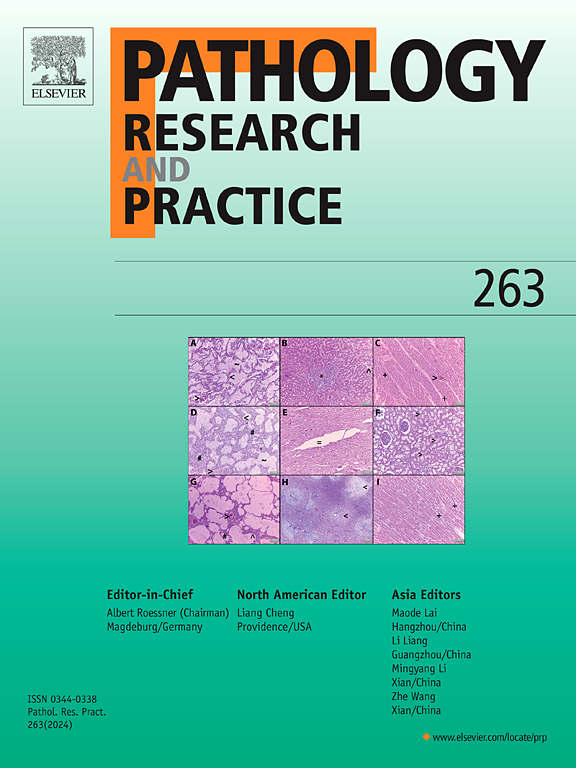人工智能辅助前列腺癌诊断的临床优势:一项初步研究
IF 2.9
4区 医学
Q2 PATHOLOGY
引用次数: 0
摘要
前列腺癌是一种常见的男性恶性肿瘤,发病率不断上升,给世界各地的病理服务部门带来了巨大的诊断负担。人工智能(AI)正在成为提高诊断效率和准确性的有前途的辅助手段。本研究评估了人工智能辅助前列腺活检(PB)诊断的临床价值,与非人工智能辅助PB诊断相比,使用Paige前列腺工具,重点关注其对根治性前列腺切除术(RP)标本特征的预测准确性。回顾性分析包括55例患者,分为两组:一组为非ai辅助PB诊断(n = 25),另一组为ai辅助PB诊断(n = 30)。病理评估记录肿瘤大小、Gleason评分、分级、分组和神经周围浸润情况。分析PB与RP结果的相关性,p为 <; 0.05,差异有统计学意义。ai辅助PB诊断报告时间缩短了24 小时,提高了工作流程效率。人工智能辅助提高了肿瘤大小在PB和RP之间的相关性,与非人工智能(R=0.479, p = 0.015)相比,显示出实质性的一致性(R=0.646, p <; 0.001)。人工智能辅助组的Gleason评分一致性增加了13 %,达到73.3 %,而非人工智能辅助组为60 %。这项小规模的试点研究表明,人工智能辅助的PB诊断似乎提高了前列腺癌诊断的效率和准确性,这一发现有待进一步的研究证实。本文章由计算机程序翻译,如有差异,请以英文原文为准。
Clinical advantages in providing artificial intelligence-assisted prostate cancer diagnosis: A pilot study
Prostate cancer is a prevalent male malignancy, with increasing incidence rates placing significant diagnostic burdens on pathology services worldwide. Artificial intelligence (AI) is emerging as a promising aid in enhancing diagnostic efficiency and accuracy. This study evaluates the clinical benefits of AI-assisted prostate biopsy (PB) diagnosis, with Paige Prostate tool, compared to non-AI-assisted PB diagnosis, focusing on its predictive accuracy for features in radical prostatectomy (RP) specimens. A retrospective analysis included 55 patients divided into two cohorts: one with non-AI-assisted PB diagnosis (n = 25) and another with AI-assisted PB diagnosis (n = 30). Pathological assessments recorded tumor size, Gleason score, Grade Group, and perineural invasion. The correlation between PB and RP results was analyzed, with statistical significance set at p < 0.05. AI-assisted PB diagnosis showed faster reporting times by 24 hours, enhancing workflow efficiency. AI assistance improved the correlation of tumor size between PB and RP, showing a substantial agreement (R=0.646, p < 0.001) compared to non-AI (R=0.479, p = 0.015). Gleason Score concordance increased by 13 % in the AI-assisted group, achieving 73.3 % versus 60 % in the non-AI-assisted group. This small pilot study suggests that AI-assisted PB diagnosis appears to enhance efficiency and accuracy in the diagnosis of prostate cancer, a finding to be confirmed with further studies.
求助全文
通过发布文献求助,成功后即可免费获取论文全文。
去求助
来源期刊
CiteScore
5.00
自引率
3.60%
发文量
405
审稿时长
24 days
期刊介绍:
Pathology, Research and Practice provides accessible coverage of the most recent developments across the entire field of pathology: Reviews focus on recent progress in pathology, while Comments look at interesting current problems and at hypotheses for future developments in pathology. Original Papers present novel findings on all aspects of general, anatomic and molecular pathology. Rapid Communications inform readers on preliminary findings that may be relevant for further studies and need to be communicated quickly. Teaching Cases look at new aspects or special diagnostic problems of diseases and at case reports relevant for the pathologist''s practice.

 求助内容:
求助内容: 应助结果提醒方式:
应助结果提醒方式:


